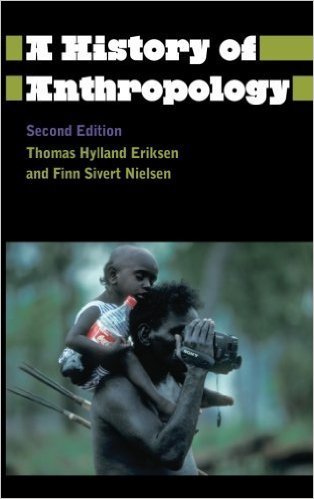

| Finn Sivert Nielsen | Anthropologist |
| Home | Search | Contact | På norsk |
| A History of Anthropology |
London, Pluto Press: 1. ed. 2001 –
2. ed. 2013 (thoroughly revised and expanded).

|
Norwegian version – Bergen, Fagbokforlaget: 1. ed. 2002 – 2. ed. 2004 (many errors corrected).

|
|
|
| By Thomas Hylland Eriksen and Finn Sivert Nielsen |
| Essay by Finn Sivert Nielsen |
Contents
— Publishing the book. Differences between the editions
— Courses on the history of anthropology in Copenhagen
— History of Anthropology Homepage
— What have I learned from all of this?
My career as an anthropologist started with a misunderstanding. After an overdose of T. S. Eliot at a tender and impressionable age, I dedicated significant portions of my youth to the books he refers to in his notes to The Waste Land. Thus I was led first to Jessie L. Weston's classic From Ritual to Romance, later to Frazer and The Golden Bough. I bravely toted home from the city library Volume One of the twelve-volume, semi-folio-sized series, and even read most of it, entranced by the romance of an anthropology that (how was I to know!) had years ago been consigned by more realistic generations to the dustbin of history.
So when I first entered the doors of the Department of Social Anthropology at the University of Oslo – housed, for the duration, in a decrepit, one-storey wooden barracks left behind by the Germans after the War (a romantic location, I imagined, not being adequately informed about the paper-thin internal walls, the rotting entrance stairs or the rats)... Anyway, as I entered this temple of romance, what did I find? Ecological anthropology and role-analysis! In time I got the point of this too, but the experience left me with an almost existential interest in the history of anthropology. How could Frazer be god for one generation and irrelevant for the next? And how come Evans-Pritchard kept referring to him anyway? It was at about this time – toward the end of the 1980's – that the idea first occurred to me of writing a history of anthropology in Norwegian. Like many other a great idea, it then curled up in a private corner and proceeded to languish for many a year.

Barracks B, the home of the Department of Ethnography (later of Social Anthropology) in Oslo. The lawns were great in the sommer, and we had our own entrance and fantastic parties! (Foto: © Ole Bernt Frøshaug)
Only when I spoke to Thomas Hylland Eriksen about the matter did anything actually happen. Thomas immediately took to the idea and within weeks had sold it to Pluto Press (for the English version), to Fagbokforlaget (for the Norwegian version), and also composed a quick draft of the entire text. Now it was my turn, and I started, in my plodding way, to fill in some details; I was also awarded the task of digging up information about the history of Nordic anthropology. The first editions were published in 2001 (English) and 2002 (Norwegian). They were quite successful, but had several clear inadequacies: The Norwegian version contained a large number of typos and mostly minor, but often misleading errors. In the English, supposedly international, version we had paid far too little attention to non-Western anthropologies.

|

|
|
|
|
During my years at Copenhagen University I had the opportunity to teach first-year students an introductory course to the history of anthropology, which ran once a week throughout an entire academic year. The Norwegian version of our History of Anthropology was used as the basic text for the course, with original readings for every lecture as well (click here to see a reading list for the course). During the six semesters that I held these lectures I developed a series of diagrams and other teaching aids, which I published online on that year's course homepage. As time passed and the course was held again, various materials accumulated on various course homepages and I decided to consolidate them all into a small history of anthropology homepage, an idea I only partly completed...
The History of anthropology homepage remains incomplete and is long overdue for a total overhaul. Even as it stands, however, the homepage contains a fairly wide range of resources, including:
— Chapter 2 from the English version of the book (1st edition, with small changes)
— Chapter 4 from the Norwegian version of the book (1st edition with corrections)
— Errata to the 1st Norwegian edition
— The graphical timelines from the Norwegian version
Additional resources that will be incorporated into a renewed History of anthropology homepage include:
— Resources developed for my courses in the history of anthropology
— Links to the course homepages of these courses
— An article comparing the development of anthropology in Scandinavia vs the Baltics
— AnthroBase - Dictionary: Look up anthropologists, schools and ideas
— Texts on AnthroBase dealing with the history of anthropology
| So what have I learned from it all? |
Maybe the most surprising insight I have derived from my more than decade-long engagement with the history of anthropology is of the foundational role played by German academic traditions in the formation of modern anthropology. All I had ever heard before about German anthropology were some vague words about the great German museums, some equally vague hints that the concept of "culture" traced its origins in unspecified ways back to German romanticism, and vague but firm assurances that 20th century German anthropology had stagnated and all but died out.
Let us consider some of the details of this story; for simplicity's sake, we'll stay with "culture." The fact that Tylor introduced the concept of culture to British anthropology is widely known, nor is it a secret that the concept had far less influence in Tylor's native Britain than in the USA – indeed, this is often pointed out at as a curiosity, a paradox. However, if you consider that Tylor was a friend and admirer of Adolf Bastian (the "father of German anthropology"), from whom he learned the importance of "culture," and that Bastian also was the teacher of Franz Boas (the "father of American anthropology"), who likely had been taught the same lesson... then the paradox dissolves. Tylor did not need to introduce the German concept of "culture" to Americans who knew it well and stood far closer to the German tradition than the British did (though of course Malinowski on the strength of his education must be considered a German).
Another interesting figure is the great German psychologist Wilhelm Wundt (the "father of experimental psychology"), whose ambitious attempt at building a systematic discipline of "Völkerpsychologie" deeply influenced many of his students, including such luminaries as Bastian, Malinowski, Durkheim, Rivers, and through them, Mauss and Boas, Radcliffe-Brown and Lévi-Strauss. Every one of the founding fathers of 20th century anthropology was thus influenced by Wundt's thoughts on the psychology of collectives. Someone really needs to write a monograph about Wundt's role in the formation of anthropology!
I have also learned a lot about the anthropological histories of the Nordic countries (the Norwegian edition of our book contains about 40 pages that deal specifically with Nordic anthropology; to my knowledge this is the most comprehensive history of Nordic anthropology to date). What has stricken me most forcefully are the national differences between these histories (see this article for details). Finland, which had its great anthropologist (Westermarck) almost two generations too early, and since then rejected all efforts to modernize the subject until the 1980's. Norway, which had its great anthropologist (Barth) at exactly the right moment, and since the 1950's has seen anthropology become widely known and a factor in national policy. Sweden and Denmark, which both had far stronger anthropological institutions than Finland and Norway, showed a more ambiguous attitude to modern innovations. In Denmark, where a single anthropological institution dominated the country, change took place, but slowly, conservatively, without ever quite relinquishing the "culturalist" ties to German – later American – anthropology. In Sweden, with several strong, competing institutions, various attitudes to modernization came to the fore, conflicts erupted, and while the anthropologists quarrelled, the ethnologists took over the large and lucrative market which the Norwegian anthropologists had so successfully cornered – anthropology at home.